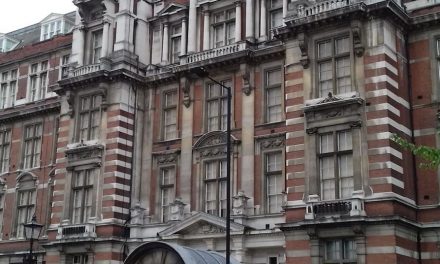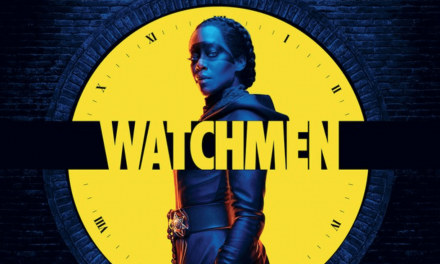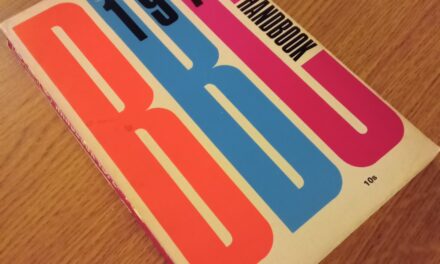It was a quiet TV night and New Tricks (2003 – 2015) was coming to an end. In the Cold Case office, the three police detectives, brought out of retirement, and their younger boss were solving the case. They were reporting on the witnesses they’d interviewed and taking pleasure in the way in which each re-told story, which had been tested out earlier in the programme, now slotted into place so that the unsolved crime could be finally resolved. As this process reached its conclusion, my partner on the sofa turned to me and said ‘this is boring, isn’t it?’ Somewhat defensively, since I know New Tricks is not exactly cutting edge television, I responded that I was enjoying it. (And despite critical disdain, it has been one of the BBC’s most popular series – see Phil Wickham’s excellent analysis referenced below for more details on this.)
Later on, I realised that I like New Tricks precisely because its old-fashioned approach to the solving of crime. It maps out Todorov’s double story – the story of the crime and the story of the detection of the crime – in the classic manner which came to television from literature. The detectives work by listening to the stories told to them by witnesses, perpetrators and victims. They listen carefully, quietly, warily with an occasional question to dig out a bit more detail. Generally the questioning takes place in the home or business so that what’s said can be put in context; is this story likely given the circumstances of the teller? Does it sound right? What jumps are being made in the telling? Who can give another version of the story? Truth is tested out by listening – for gaps, discrepancies, uncertainties in the telling. In contrast with the thriller, the detective faces very little jeopardy and in the conclusion s/he tells us the story of the murder with all the details apparently in place.
New Tricks is old-fashioned but this structure of telling the detective story is still prevalent. Just now we can see it at work in ITV’s Unforgotten (2015). Perhaps not co-incidentally, DCI Cassie Stuart (Nicola Walker) is also working on a cold case. A body is found under the concrete floor in a house being demolished. It turns out to be the body of Jimmy Sullivan (Harley Sylvester) who died, and was possibly murdered, in 1976. There are a host of suspects and Stuart and her colleagues listen patiently, and several times, to the stories each of them tell about knowing (or not knowing) Jimmy. At the same time, the DCI is also unusually good at listening to and then organising her team. She responds to each snippet of information and allocates them to do more listening, more testing out.
%20arrive%20to%20question%20Sir%20Phillip%20Cross%20(Trevor%20Eve)%20in%20Unforgotten.jpg)
But another faculty for detecting came to the fore many years ago – the act of looking. It arguably started with a shift to the role of the forensic pathologist in CSI (2000 – 2015). But the name of the British programme, Silent Witness (1996 – ) indicates most clearly what’s at stake in this shift. The silent witness is of course the dead body in the morgue and since it cannot speak the pathologist/detective cannot listen but only look, taking patient care to observe every tiny thing that the body can reveal. In Silent Witness, the act of looking became almost mystical; Sam Ryan (Amanda Burton) seemed to want to be the conduit through which the silenced victim could speak.
Police detectives don’t have the skills of the pathologists but it is striking that the act of sustained looking has become crucial to police procedurals. Much evidence-gathering is done by looking at CCTV footage but of greater importance is the change in the crime board. What was a specialist notice board is now a transparent wall of glass on which photographs and other images are placed. As with the corpse on the slab, so the sad faces and bruised and bleeding bodies mutely plead for their story to be told. And detectives respond by staring at these images as if by looking they can move through the glass wall and make the silence give up the solution.
River (2015) also currently screening on BBC1 is a rather odd example of this emphasis on seeing. The isolated, depressed detective DI John River (Stellan Skarsgard) stares at faces, at crime scenes and at photos. In episode 2, for instance, he establishes a suspect’s alibi by re-examining photos which have been looked at before but not carefully enough. And in episodes 3, he learns as he has been looking in the wrong direction; ‘I don’t care that you’re looking at me’ another suspect tells him. ‘I care that, while you are, you’re missing someone else’. The episode ends with River pinning a CCTV image of Stevie with ‘someone else’ to his own crime board.

Skarsgard’s intense and rather gloomy act of looking has been ascribed to the influences of Nordic Noir and the same has been said of the aptly-named French series, Witnesses (Les Témoins, 2014) filmed around the seaside town of Le Tréport on the north coast of France. In the latter, Lt. Sandra Winckler (Marie Dompnier), a brave and intuitive detective, investigates a mystery involving disinterred dead bodies which are posed in show homes in a manner which seems to indicate an act of revenge. The first clue is a photograph carefully positioned in the show home and Winckler spends much time staring at photos of the victims, re-viewing the crime board and seeking inspiration by looking out at the grey sea.

But when seeking Nordic connections, it’s worth bearing in mind that even the pragmatic Vera (Brenda Blethlyn) in the ITV series of that name (2011 – ) spends a lot of her time trying to get into the mind of the victims by looking at their photos on the crime board. Like Sam Ryan in Silent Witness and others who seek to solve murders by looking, she too feels an empathy with the victim and somehow wants the solved crime to provide a peaceful resolution. River pushes this to its extreme for River does see and talk to the dead, most crucially his murdered partner Stevie (Nicola Walker); this is ascribed to his fragile mental health but in terms of detecting River actually fulfils the ambition of many modern detectives of resurrecting the dead so that he give them some sort of justice.
Both listening and looking require patience and care. But the latest way of solving crimes involves no such restraint. There were signs of this approach in the French Engrinage (Spiral 2005- ) in which the detectives make decisions rapidly and spent little time on reflection. But it is the later French police crime drama Braquo (2009- ) which really demonstrates the new mode of jumping to conclusions. Of course the police in the SPDJ do hear and see things but they don’t really listen or look so they never take a moment to test out the evidence of their senses. Instead, in each episode they learn something (which may or may not be true) and immediately jump to a conclusion which drives them into a reaction. Perhaps it’s not co-incidental that in this version of a police procedural, the police are as violent and brutal as the criminals and themselves regularly commit crimes of violence and robbery. Detective work is visceral, spectacular and driven by instinct.

But this approach is not confined to Paris and rather bizarrely could be seen in the BBC’s recent Dr Foster (2015). Here the role of ‘detective’ is taken by Dr Gemma Foster (Suranne Jones) who comes to suspect that her perfect family and successful career are threatened by her husband’s affair with the daughter of family /business partners. Gemma jumps to conclusions and turns detective. But her methods are instinctive and implausible, breaching her own codes as a GP, drawing her friends and patients into her network of spies and generally shouting, crying and carrying on. Like the detectives in Braquo, one word, one gesture, one suspicion sets her literally driving off in another direction. The roundabouts of Gloucester have rarely seen such action.
.jpg)
Dr Foster is a crossover between the detective story and soap opera and River may turn out to be the same, depending on how its remaining episodes play out. But all these programmes exemplify in varying degrees a shift in the detective series from realism to melodrama, from the rational testing of witnesses to the emotional positioning of the detective with the victim. Even the brutal Braquo offers a macho combination of violence and sentimentality. And so it was interesting to see this shift confirmed in the reaction of the viewers on Gogglebox (2013, Channel 4) to Dr Foster. At the end of episode 2, Gemma cries as she tells her husband (Bertie Carvel) that she thinks he is having an affair and informs him what lying about it would mean to her. The watching viewers on Gogglebox waited in tense silence for her husband to respond, bursting into shouts of disbelief when finally he faces her and lies. In true soap terms, the suspense depended not on the complications of the plot or the vindication of Gemma’s detective work but on her husband’s moment of deliberate betrayal.
Christine Geraghty is an Honorary Professorial Fellow at the University of Glasgow. Her publications on television include a contribution to the 1981 BFI monograph on Coronation Street; Women and Soap Opera (Polity, 1991); and My Beautiful Laundrette (I B Taurus, 2004). Her BFR TV Classic on Bleak House was published in 2012 and her reflections on the beginning of her work on soap opera appears in ‘The BFI women and film study group 1976 – ?’, Renewing Feminisms, Radical Narratives, Fantasies and Futures in Media Studies H. Thornham and E. Weissmann (eds) I B Taurus 2013. She is on the editorial board of the Journal of British Cinema and Television and sits on the advisory boards of a number of journals, including Screen.





